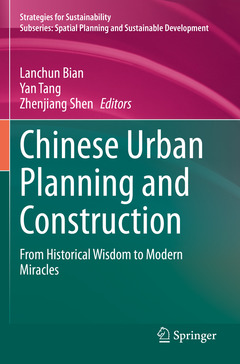Description
Chinese Urban Planning and Construction, 1st ed. 2021
From Historical Wisdom to Modern Miracles
Spatial Planning and Sustainable Development Series
Coordinators: Bian Lanchun, Tang Yan, Shen Zhenjiang
Language: English
Subjects for Chinese Urban Planning and Construction:
Publication date: 05-2022
332 p. · 15.5x23.5 cm · Paperback
Publication date: 05-2021
332 p. · 15.5x23.5 cm · Hardback
Description
/li>Contents
/li>Biography
/li>Comment
/li>
This volume introduces and discusses the achievements and mechanisms of urban planning and construction in China from multiple professional perspectives, covering practices and processes ranging from ancient times to the present day. The book has 14 chapters, each addressing a specific Chinese urban planning and construction topic with examples and applications in various cities and regions, and each providing an all-around analysis of Chinese urban development issues at different scales, including government administrations, planning progresses, urban investments, social impacts and construction models. The book provides a comprehensive overview of urban planning and construction in China, especially its successful experiences in the historical period and modern era, which will greatly benefit scholars and readers who are interested in China, as well as urban planners, architects and historians.
The book is organized into 4 main parts. Part 1 focuses on "historical wisdom" to summarize ancient Chinese efforts to cope with nature and the environment. It interprets the unique wisdom of ancient Chinese cities related to regional design, water conservancy system, and urban districts. Part 2 presents the ?transformation" of urban planning in China by learning from both the traditional value and western experiences based on several cases, such as the spatial development of Beijing and the Beijing-Tianjin-Hebei capital region, the preservation of Qingdao city, the urban community development and regeneration in Chongqing city. Part 3 explores the "green and eco-city" by looking towards the future, illustrating Chinese practices and efforts to build more sustainable cities, such as green and low-carbon city construction in Wuhan, healthy city planning and eco-cities construction in China. Part 4 prospects the ?modern miracles? brought forth by technological innovation and economic growth, and introduces the newest planning trends in China, such as the E-commerce Taobao villages in China and the innovation districts in Beijing. It also explains the driving force of the "growth machine" of Suzhou city.
Dr. Yan Tang is an associate professor at the School of Architecture, Tsinghua University, Beijing, China. She is an editor in charge of China city planning review, deputy secretary general of Urban Regeneration Committee of China Urban Planning Society, committee member of Urban Design Committee of Architectural Society of China, and committee member of Eco-city Committee and Resilient City Committee of Chinese Society for Urban Studies. She also works as the secretary of Architecture Discipline Appraisal Panel, Academic Degree Committee of the State Council of China. Her research interests include urban design and planning, urban regeneration, and urban and rural governance. She is a registered urban and rural planner in China, and her work always highlights the combination of research and practice.
Dr. Lanchun Bian is a professor at the School of Architecture, Tsinghua University, Beijing, China. He is an executive director of China Urban Planning Society; a vice-chairman of Urban Design Committee, vice-chairman of Urban Regeneration Committee, and committee member of Historical and Cultural City Preservation of China Urban Planning Society, as well as the vice chairman of Beijing Urban Planning Society. He is also a committee member of the Expert Advisory Group of Beijing Historical and Cultural City Preservation. His interests mainly focus on urban design theory and practices, historical and cultural heritage preservation and residential planning. He has published five books and dozens of academic papers.
Dr. Zhenjiang Shen is a professor at the School of Environmental Design, Kanazawa University, Japan. He is a member of The Engineering Academy of Japan from 2018, whose research interests include smart city construction, policy-making support system for planning and design using GIS, VR & Information Communication Technology (ICT). He is a commission member of Commission on Geospatial Analysis and Modeling of I
Provides 14 unique experiences on urban planning and development achievements in China
Offers a comprehensive analysis, combining domestic and international perspectives, on Chinese urban issues
Addresses historical, contemporary and future practices of Chinese urban planning and construction




